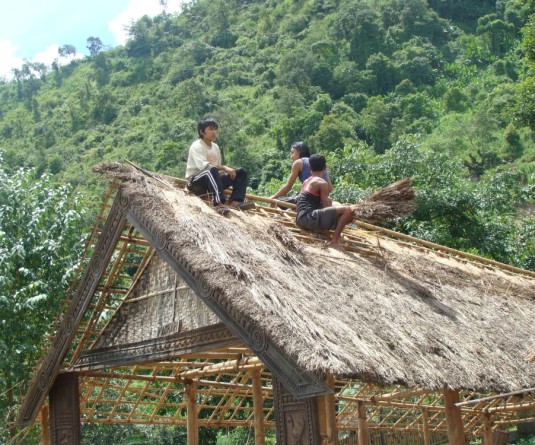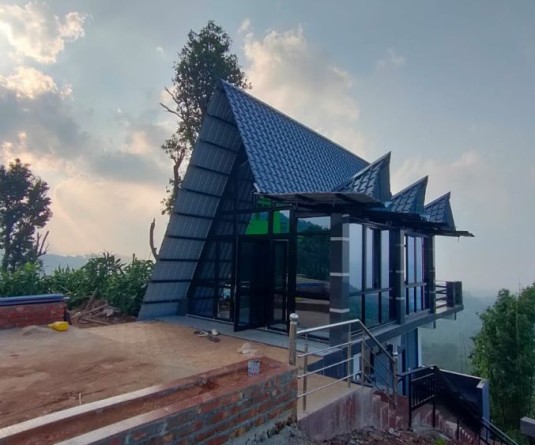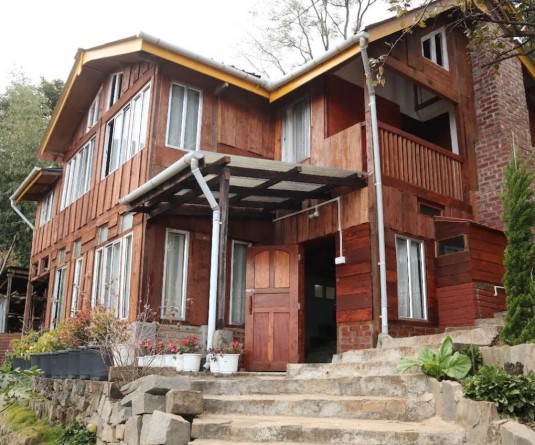Villagers participating in oiled pole climbing- a traditional game during the feast in Gariphema.
Vibi Yhokha & Victor Dzüvichü
Kohima | January 7
Nestled 54 km away from the Nagaland State capital is the village of Gariphema, well known to many as the birthplace of the revivalist movement in Nagaland and more specifically the birth of the Nagaland Christian Revival Church (NCRC). However what many people are unaware of is the story of two tribes who have lived together since the formation of the village.
Tradition has it that about 1,200 years ago, when our fore fathers were still head-hunting, a Sumi and a Tenyimia from opposite directions came surveying a mountain to set up a village. When one of them came and lit a fire, the other would come and put out the fire. The same happened when they put up Khutige (Khutige is a ball of leaves with sharp sticks running through the ball of leaves, put on a long split stick, to identify that a particular land has an owner).
Each of them after lighting a fire or putting up signs, would go back home only to come back the next day and find their work destroyed by the other. This continued until one day, they finally met face to face. Spears were raised at the faceoff, however something passed through their minds simultaneously as both sides decided to put their weapons down and negotiate.
When they began to converse, realization dawned that they could not understand each other’s dialect; however the two managed to make peace with each other through sign language. With their feet they drew a line on the ground and waving at each other indicated, “You stay on that side, and I will stay on this side,” thereby setting up the village together. Tradition has it that the present playground was once a big lake and was surrounded by a species of edible leaves called “Gari,” from where the village derived its name. Gariphema is considered as one of the oldest villages in Nagaland.
“To live in man’s ideas is impossible”
If you ask anyone in Gariphema about the one thing that has kept them together all this time, the likely answer is, “To live in man’s ideas is impossible. It is all because of God alone.”
Their belief in God, and in one denomination, is perhaps a major reason for their unity. Christianity in Gariphema arrived in 1944. It was in Gariphema that the NCRC was formed in 1962 - a time when the revivalist movement was at its zenith in Nagaland. In 2012, NCRC celebrated its golden jubilee. Every year, the Pentecostal Day is celebrated in Gariphema where people, not just from Nagaland, but from states like Assam, Manipur and Arunachal also attend.
Around the village are found bible verses written in blue and white paint on the walls in open spaces. There is an aura of deep spirituality among the people; you understand it in the way they owe everything to God with genuine praise and sincerity.
Gariphema Women Society
For decades, the Gariphema Women Society has been the driving force in banning alcohol and tobacco in Gariphema village. Every day the women take turns to check every vehicle entering the village. “Sometimes our women would go out for checking at night without sleeping. We never get tired or disappointed because we, the women, have been assigned this duty by the village council. And it is a great pleasure for us to be serving with such a role,” says Yeshili Khana, Chairman of the Gariphema Women Society.
Ask Yesheli what has kept them together, she says, “I think we have never differentiated each other. We have never labeled any one of the community as the ‘other’.”
At a time when Nagaland undergoes a phase of violence and unrest, Gariphema is not just a tale of two tribes coexisting harmoniously for centuries but it is a tale of hope, faith and love that we Nagas are and can be much better than what we are right now.
“United we stand,
divided we shall fall”
As one walks through the village one can’t help but feel amazed hearing the conversations of the villagers as one person talks to the other in Tenyidie; while the latter replies in Sumi, with just one church and the whole village Christians, Gariphema village is a symbol of peace and tranquility. Talking to Krüso Chiese, our host at the village, we learnt that the villagers believed disunity among the villagers would bring forth God’s wrath upon the village.
Krüso further related on the cross culture tribal marriage that was prevalent among the villagers, the villagers still respect the territorial boundary their two ancestors drew about 1,200 years ago, with the village divided into a Sumi khel and an Angami khel. Yet these boundaries do not represent in any way distinction on the basis of language or tribe. It only signifies how they still respect the statutes of their fore fathers.
On the northern side of Gariphema, one can see Lazami and other Sumi villages, while on the southern side, one can see the Angami villages. At a time when “isms” have shrouded every society in the world, the villagers of Gariphema village have shown, in their simplest ways, how people from every walk of life can live together in perfect harmony, leaving aside all differences, forgetting about the different cultures we share and contending ourselves under the common umbrella of humanity.






